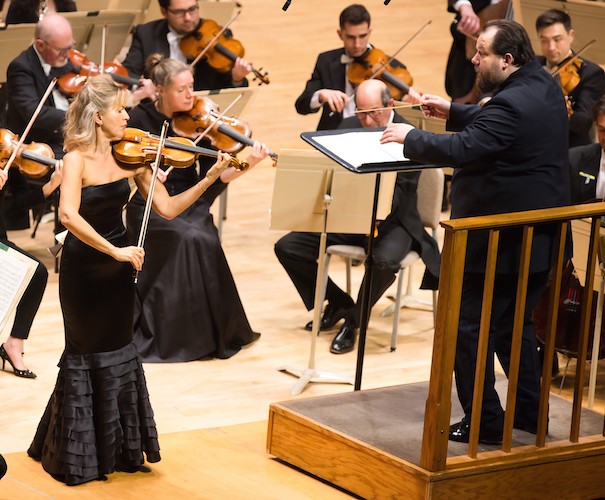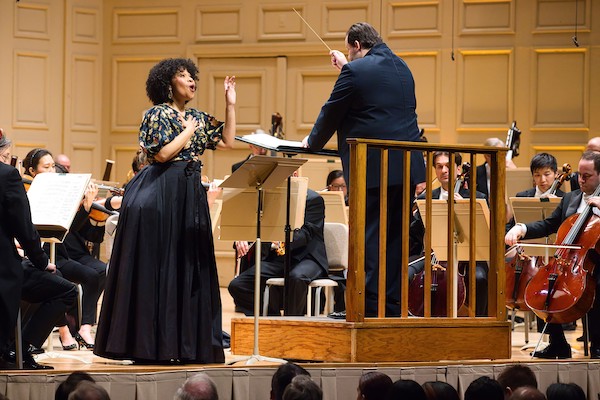Classical Concert Review: The Boston Symphony Orchestra and Anne-Sophie Mutter — Together Again
By Aaron Keebaugh
If Andris Nelsons’s direction revealed one thing, it’s that violinist Anne-Sophie Mutter and composer Thomas Adès make a stellar musical pairing.

Violinist Anne-Sophie Mutter performing the Mozart Violin Concerto No.1 with the BSO and music director Andris Nelson. Photo: Hilary Scott
Few artistic partnerships have resulted in as many successful new works as that of Anne-Sophie Mutter and the Boston Symphony Orchestra.
Over the past decade alone, the superstar violinist has served as catalyst for arresting new concertos by André Previn and John Williams, both recorded by the BSO. Now, Mutter is the force behind Air, a fresh score by Thomas Adès that she performed with the orchestra for the first time in the US this past weekend. And if Andris Nelsons’s direction revealed one thing, it’s that Mutter and Adès make a stellar musical pairing.
Air is as much an homage to Jean Sibelius as it is a showpiece for Mutter’s lyrical sensitivity. Throughout its 13 minutes, lines weave together with mesmerizing formal logic. But it also sings and shimmers, each phrase an echo of the former. Mutter’s line glowed through the soft fog of strings, a vital part of the collective without being subsumed by it.
Even for Mozart’s Violin Concerto No. 1, Mutter struck an ideal balance between soloistic flair and complementary blend. Indeed, many soloists tend to see this music by the teenage Mozart as a mere show. But Mutter relished its fleeting lyricism while simultaneously displaying the requisite fireworks. She injected a slight edge into her tone that made her arpeggios and wild flourishes in the first movement course with urgency. So did the final movement, with double stops framing each line of cadenzas by Hans Sitt.
The Andante revealed an almost romantic plushness. Mutter’s generous rubato wafted the melodies into long arcs. In support, Nelsons wove a soft bed of accompaniment.

Soprano Golda Schultz performs Sibelius’s Luonnotar with the BSO. Photo: Hilary Scott
Music by Sibelius, which rounded out the program, offered greater contrasts.
The tone poem Luonnotar, scored for soprano and orchestra, conveys a Finnish creation myth in all its primordial storm and darkness. In deft contrast, soloist Golda Schultz projected a lyrical warmth and vigor — a touch of humanity was woven into the mystery. Nelsons painted an effectively dark background, with hushed strings and winds emitting an understated gravitas.
With Sibelius’s Symphony No. 5, Nelsons made what often feels like an exercise in musical abstraction surge with brutal vitality.
This 1915 score compresses romantic gestures within a sleek form. But Nelsons focused on the grand picture. Textures in the first movement slid together like glaciers — gradual, but with seismic tension. Yet there were beautiful moments along the way. Velvety calls from trumpets floated easily over the first movement’s vastness. Woodwind lines in the second movement flowered in all the right places. In the finale, figures teemed and soared straight to the concluding statements. For an instant, Mahler’s point about symphonies being worlds unto themselves — often the antipode of Sibelius — rang true.
The program heads to Carnegie Hall tomorrow. Catch it if you can.
Aaron Keebaugh has been a classical music critic in Boston since 2012. His work has been featured in the Musical Times, Corymbus, Boston Classical Review, Early Music America, and BBC Radio 3. A musicologist, he teaches at North Shore Community College in both Danvers and Lynn.
Tagged: Andris Nelsons, Anna-Sophie Mutter, Boston Symphony Orchestra, Golda Schultz

We feel so fortunate to have attended the second night. And Nelsons closed the evening with the Sibelius 5th Symphony in a performance that left the audience not wanting to leave.